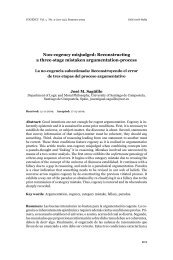Cogency v2 n2
Cogency v2 n2
Cogency v2 n2
Create successful ePaper yourself
Turn your PDF publications into a flip-book with our unique Google optimized e-Paper software.
COGENCY Vol. 2, N0. 2, Spring 2010<br />
of incompetence were he to draw a different interpretation than theirs from<br />
the visual image. By Wittgensteinian lights, they need an account of what it<br />
is to misunderstand an image that compares perspicuously with what it is<br />
to misunderstand a linguistic utterance. If there is no such account to be<br />
found, as I suspect there is not, then visual images are like Wittgenstein’s<br />
pictures. By themselves images may spur cognitive feelings or associations–<br />
and so may be persuasive–but they lack an internal pattern, the recognition<br />
of which would allow them to be the presentation of an illative move from<br />
premises to conclusion. Hence they do not seem to carry propositional content<br />
other than that which is assigned to them or framed by the caption<br />
(and what is a caption, but set of directions for how to interpret the image).<br />
12 And if images on their own are not propositional, then visual images<br />
cannot be arguments of the sort that Birdsell and Groarke contend.<br />
Smith (2007) has suggested a path that seems as if it might avoid this<br />
objection. According to Smith, the ability to draw at least one possible reading<br />
of the image that qualities as an argument is enough to say that the<br />
image contains an argument. Quoting Birdsell and Groarke’s (1996: 8) example<br />
of holding cake under a dieter’s nose as a way of arguing that he should<br />
eat it she says: “This example illustrates enthymematic argument as I conceive<br />
it. Multiple interpretations are possible, some of which can be considered<br />
arguments for the dieter to consider.” (Smith 2007: 119) Birdsell and<br />
Groarke might wish to say something like this as well. As long as one interpretation<br />
of the image reads it as a proposition then they are safe. However,<br />
this move does not succeed. For, Birdsell and Groarke must now hold that<br />
every picture admits of a set of interpretations some one of which is propositional<br />
in the way required for their to be an argument. The 139b problem<br />
remains: which interpretation is it and why should we treat with it rather<br />
than any of the others at any given instance. Why would we be wrong if we<br />
did not do so? And if, as I suggest in the next section, the propositional<br />
12<br />
An appreciation of the significance of this problem of relating the sign to the signified<br />
in Wittgenstein’s works in both its logical and phenomenological dimensions can be found<br />
in Munson (1962).<br />
122








